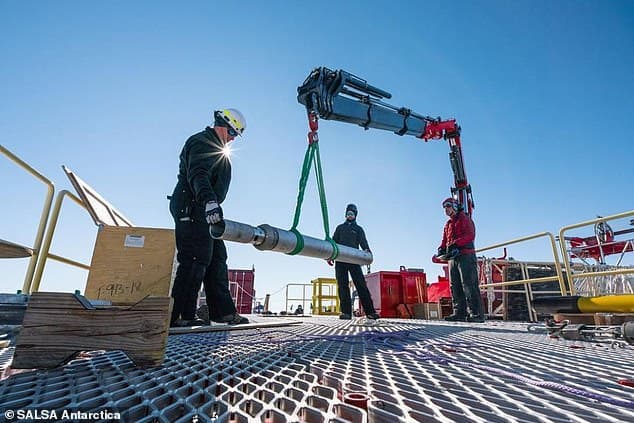
Scientists in Antarctica have finally drilled into a mysterious lake buried under more than 3,500 feet of ice in a bid to find out if life exists there.
Mercer Subglacial Lake is a hydraulically active lake that lies more 1000m beneath the Whillans Ice Plain, a fast moving section of the West Antarctic Ice Sheet.
The pool of water, known as Subglacial Lake Mercer, measures nearly 62 square miles, was discovered more than a decade ago through satellite images but has never been explored.
It is one of 400 lakes beneath the Antarctic ice – and experts say any life there could raise hopes of finding similar organisms deep inside Mars or on the ice-covered moons of Jupiter and Saturn.
The Subglacial Antarctic Lakes Scientific Access (SALSA) team said it took two days of drilling to reach Mercer Subglacial Lake on Dec. 26.
The team melted their way through an enormous frozen river with a high-pressure, hot-water drill.
‘After four days of troubleshooting components that sustained wear and tear from sitting through two winters on ice, the Drill Team began drilling the main borehole on the evening of December 23 and reached the lake faster than expected at 10:30pm on December 26 with a borehole depth of 1084 meters,’ it said.
A team of researchers — which includes 45 scientists, drillers and other staff members — with the organization were able to send an instrument down a borehole the next day.
They will also lower a remotely operated vehicle down the hole to capture more footage and take more extensive measurements.
It is hoped the submersible’s three video cameras might capture images of animals that live in the dark water.
‘We don’t know what’s going to be there,’ John Priscu, a lake ecologist at Montana State University in Bozeman and leader of the project told Nature.
‘That’s what makes it so much fun.’
Some of the researchers drilled into a nearby, smaller subglacial pool called Lake Whillans in 2013, and found it teeming with microbes.
The group plans to study the depth, temperature and cleanliness of the lake over the next few days.
Part of the drilling process involves sampling the drill water to test its cleanliness.
The water has been tested twice thus far, and both tests showed the water was ‘as clean as filtered water can get’, in the words of SALSA PI Brent Christner.





























